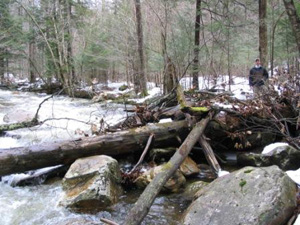Wood Dynamics in Northeastern Stream Systems

Wood serves multiple functions in stream ecosystems and the relative importance of wood in a stream can depend upon multiple biotic and abiotic factors. For the purposes of my research, I have focused on “large wood” defined as dead wood in the stream channel greater than 10 cm diameter and greater than 1 m length, an operational definition that has become well established in the literature.
Wood Movement
In fall 2000 I tagged 116 pieces of large wood in a second-order section of Rocky Branch, a stream in the eastern Adirondack Mountains of New York. I returned to this 400 m section of stream in 2001, 2003 and 2004. Results from this assessment of wood movement through a period of moderate spring flooding was published in 2008 (Warren et al. 2008)
Wood Distribution
Given the importance of wood to stream biota and stream biogeochemical processing, understanding how wood is distributed in a system can provide insights into how organisms and stream processes may be spaced within a stream. Areas of wood aggregation– debris dams – can be quantitatively assessed using a linear modification of a neighbor K analysis (see Kraft and Warren 2003), and periodicity in wood accumulation in this analysis can reflect regularity in debris dam formation. We revisited this analysis and refined it to better account for wood distribution within specific distance intervals in a 2012 publication (Kraft et al. 2012). This revised analysis evaluates whether the number of pieces of wood (or any item analyzed along a single dimension) occurring within a specific distance interval is consistent or inconstant with what one would expect by random chance alone.
Wood volume in mixed hardwood-conifer forest streams
I am developing a conceptual model to explain the large wood standing stocks in streams running through mixed hardwood-conifer forests. I suggest that for these streams input rates are most strongly related to riparian forest age and output rates are most strongly controlled by the width of the stream relative to the length of in-stream wood. These two features should together explain a large amount of the variability in the volume of large wood in a stream. I am assessing the conceptual model using data that I have collected in collaboration with other researchers and data from other published studies. A recent study by Dr. William Keeton and others (Keeton et al. 2007) evaluates the abundance and volume of large wood in streams and riparian zones from mature and old-growth forests in the Adirondack Mountains of New York. I then expanded on this work to evaluate wood loading across a range stand ages (Warren et al. 2009)
Collaborators
- Dr. William Keeton
- Dr. Gene Likens
- Dr. Clifford Kraft

